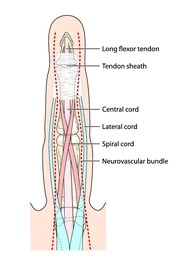

What is a Boutonniere deformity?
A Boutonniere deformity is an injury to the tendons in your fingers that usually prevents the finger from fully straightening. Tendons that run along the side, top and bottom of the finger work together to bend and straighten the fingers. The top of the tendon attaches to the middle bone of the finger and is called the central slip. The finger cannot fully straighten when the tendon is injured.
 A Boutonniere deformity can develop immediately following an injury or it can develop later. A patient will experience swelling and pain on top of the middle joint and middle bone in the finger.
A Boutonniere deformity can develop immediately following an injury or it can develop later. A patient will experience swelling and pain on top of the middle joint and middle bone in the finger.
Common Causes
A Boutonniere Deformity is usually caused by impact to a bent finger. A cut on top of the finger can sever the central slip from its attachment to the bone. The tear can look like a buttonhole. This condition can also happen without a specific injurious event in people who have rheumatoid arthritis.
Diagnosis
To receive a diagnosis, a qualified healthcare professional in musculoskeletal disorders will first take a medical history and conduct an examination of the fingers and hand. The physician will have the patient straighten the affected finger and X-rays may be recommended to determine if there are any broken bones attached to the central slip of tendons.
Treatment
Copyright © www.orthopaedics.win Bone Health All Rights Reserved